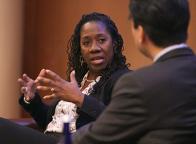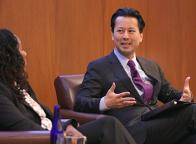When the law is used properly, it has the power to create facts, asserted Sherrilyn Ifill ’87, president and director-counsel of the NAACP Legal Defense and Educational Fund (LDF), at the most recent installment of the Center for Diversity, Inclusion, and Belonging’s speaker series. Through courtroom litigation, she continued, lawyers can establish narratives that, if endorsed by judge or jury, become legitimated. Ifill noted that this is a particularly significant power right now, in what she described as the “post-truth” era, in which the political divisions in the US include differences not only in ideology, but also in which sets of facts are accepted as truths or dismissed as “fake news.” In a conversation with Kenji Yoshino, Chief Justice Earl Warren Professor of Constitutional Law and the center’s director, Ifill addressed how the law can be used to shape and preserve civil rights narratives, even the midst of what she called today’s “narrative crisis.”
“There are a set of powerful narratives that have come to define this country in important ways,” Ifill said, referring to the racial justice narratives that emerged from the civil rights movement, such as the stories of the Freedom Rides, the Montgomery bus boycott, and the march across Edmund Pettus Bridge in Selma, Alabama. These stories “were created by the real-life engagement of black people who said, ‘We’re not going to accept this anymore,’” Ifill said, explaining that the narrative built by these stories became the dominant understanding of the civil rights movement.
That narrative was so powerful, she continued, that it has been hard for civil rights lawyers to imagine that there might come a time when these civil rights stories would not prevail in the public consciousness. “But other people were creating other narratives,” Ifill said. “And now we’ve reached a culminating phase where there are just false narratives… and this is where law becomes most important.”
Yoshino agreed, stating, “There’s never been a more important time to be a lawyer.” Adding that both he and Ifill often appear on television news programs to discuss political and legal issues, Yoshino highlighted the difference between a lawyer’s ability to build a factual narrative in the courtroom and an advocate’s ability to establish a set of facts on a television news panel. In particular, Yoshino recalled participating in a television segment in which he debated an opponent of marriage equality. He remarked that his interlocutor made a factually incorrect claim just before the segment ended, leaving Yoshino no time to make a rebuttal. “In media,” Yoshino said, “you only have a nanosecond to make your point.”
In contrast to the hurriedness of debates between television pundits, both Ifill and Yoshino noted that through the process of litigation, lawyers are able to take more time to provide their facts—and challenge their opponents’ arguments. Ifill gave as an example the Texas voter ID law that NAACP LDF has repeatedly contested in court. On television, both sides of the argument about voter ID are often given equal weight, but in the courtroom, the NAACP LDF has been able to make and win the case four times. “We can prove that 600,000 people in Texas are disenfranchised by the voter ID law,” Ifill said, “and they can’t prove that there’s any widespread voter fraud.”
Ifill emphasized that it is extremely important for all lawyers—whether they are trial attorneys or sitting judges—to have the ability to probe and review the narrative assumptions that they make, even about their own lives. She pointed to those who believe that their families achieved economic success solely through hard work, who might not realize that that the US government enabled their parents’ economic stability through the GI Bill, 1944 legislation that helped veterans attend college and purchase homes. Because most black Americans were excluded from the housing provisions of that bill, it contributed to the wealth disparity between white and black populations in the post-war era. “We need to recognize the ways in which we are none of us here by our own personal merit, but by the work of people who came before,” Ifill said.
In recognizing the work of past civil rights advocates, Ifill contended that it is also imperative for lawyers today to recognize that the narrative of civil rights is not one in a “sepia-toned” past. “There is an existing apparatus designed to oppress, just as that apparatus was designed to oppress 60 years ago,” she said. Particularly at this moment in American politics, she added, “There is a political structure that is quite interested in reinforcing that apparatus—and so it’s a very dangerous moment indeed.”
Watch the full video of the event (1 hour, 7 min):
Posted May 2, 2017

